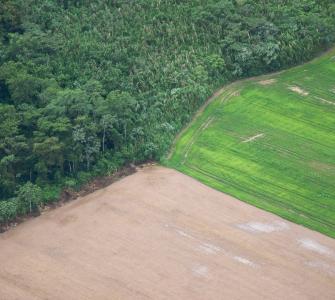CSF-Brazil conducted a study to subsidize the design and implementation processes of the Cotas de Reserva Ambiental (CRA, Environmental Reserve Quotas) market regulations by the Brazilian States to help conserve the forest in a more economically efficient and environmentally sound way.
Rural properties in Brazil play an important role in biodiversity and natural resource conservation. Under Brazilian law, owners must maintain at least 20% of their total land area with native vegetation. These areas are called “Legal Reserves” (LR) and are intended to maintain forested areas and their ecosystems, ensuring ecological balance in the region. However, many properties have yet to meet these requirements consequently creating a deficit of LR. Established in 2012 by the Forest Code, the CRA is one of the Brazilian law compliance mechanisms. The CRA program creates a market through which landowners, with LR deficits from as early as 2008, can meet their legal obligations by purchasing quotas, and thus protect an equivalent native vegetation area located on others’ properties. This market mechanism has the potential to be a very efficient conservation tool for native vegetation areas with high environmental value.
The CRA market regulation at the federal level is being developed and has not yet been completed. This has been supported by wide debate that involved the Brazilian Ministry of the Environment, Brazilian Forest Service, Brazilian Rural Society and environmental NGOs, among others. Once the federal market regulations are established, it will be up to Brazilian States to regulate CRA transaction conditions within and among states. Given the present state of CRA, the second half of 2017 seemed an appropriate time for an exchange of experiences and discussions on challenges and opportunities for the CRA market implementation at the state level.
Thus, CSF-Brazil conducted a study aiming to identify the best strategies for the efficient operation of the CRA mechanisms within and among states, as well as for forest compensation in a broader manner, incorporating the lessons learned along the process. To do so, we gathered data via extensive literature review and interviews with managers from government environmental departments from 15 Brazilian states. Then, we conducted a seminar, in partnership with the Forest Code Observatory, a group of NGOs that monitors the implementation of the Forest Code and its programs.This event's goal was to promote an exchange of experiences, visions and technical information about the CRA among state and federal government managers and researchers on this topic. Finally, we systematized the suggestions on these issues of the states more advanced in the process, and its main challenges with the implementation and functionality of this regulation.
Several studies, such as the one carried out by CSF in the state of Bahia in 2016, indicate the importance of prioritizing areas of high environmental relevance, so-called "priority areas", so that the CRA market achieves better environmental results.
Ultimately, we hope this study will promote the incorporation of the technical guidelines into future state regulations -- which still depend on the approval of the federal regulatory decree -- thus promoting more economically and environmentally efficient forest conservation.
This project was conducted in partnership with the Forest Code Observatory (OCF) and with support from the Good Energies Foundation.
To read the full study, please click here (Publication in Portuguese).
Photo: An area of a native forest in the Amazon next to deforested land being used for agriculture.
Photo credit: Sam Beebe.

